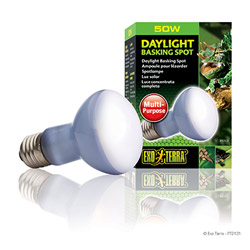Lighting

Aquarium Lighting
Fluorescent lamps are the long thin bulbs you put in aquariums to light up your tank. They come in a range of sizes and colours that lets you customise your lighting set up to get the most out of your aquarium's arrangement.
The variety of colours available are designed to bring out the qualities of your tank, ranging from pink-white bulbs that encourage plant growth and bring out the colours in tropical fish, to more natural white bulbs which try to resemble natural light through to blue bulbs which attempt to replicate the conditions of deeper water.
If you aren't sure which style of light is best for your aquarium you can read this guide to get a better idea of the differences between the lamps.
These bulbs require a lamp controller which contains the switch and electronics required to get the most out of your bulbs. We stock all the required parts to get your aquarium lighting up and running, with bulbs from multiple manufacturers.
Vivarium Lighting
Ultra-violet Light
Reptile lighting covers a large spectrum of requirements depending on which reptiles you are planning to keep.
Ultra-violet lights are required for many reptiles, from turtles to bearded dragons. The UV produced by these bulbs is vital for allowing a majority of reptiles to absorb the minerals and nutrients contained in their food. Without UV many reptiles are unable to metabolise calcium which can lead to bone disorders.
Nocturnal species such as the majority of snakes and geckos do not require UV, however any reptile that is diurnal (has an active day/night cycle) will require UV light.
Heat Lamps
Heating for most diurnal species of reptile is best provided by an overhead radiant heat-source, mimicking their natural heat lamp - the sun. Selecting the right heat lamp for your reptile is learning what temperature you will require. Whilst some desert lizards may require a 100° basking spot that will be too hot for their jungle dwelling cousins.
Most heat lamps temperature will be decided by their wattage, with the wattage required being dependent on the size of their enclosure and the animal they're heating. A large vivarium will require a more powerful bulb to reach the higher temperatures.

 Coldwater, Tropical & Cichlids
Coldwater, Tropical & Cichlids
 Pythons, Boas & Colubrids
Pythons, Boas & Colubrids
 Agamas, Iguanas, Geckos & More!
Agamas, Iguanas, Geckos & More!
 Tortoises & Turtles
Tortoises & Turtles
 Frogs, Toads & Newts
Frogs, Toads & Newts
 Spiders
Spiders
 Hedgehogs, Mantids & More!
Hedgehogs, Mantids & More!
Monday - Saturday: 10am - 5:30pm
Sunday: 10am - 4pm
(Hymenopus coronatus)
(Pantherophis guttatus)
(Pantherophis guttatus)
(Rhombodera Kirbyi)
(Sphrodomantis gastrica)
(Hierodula membranacea )
(Correlophus ciliatus)
(Brachypelma smithi)